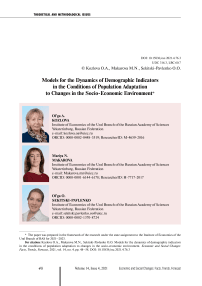Models for the dynamics of demographic indicators in the conditions of population adaptation to changes in the socio-economic environment
Автор: Kozlova Olga A., Makarova Mariya N., Sekitski-pavlenko Olga O.
Журнал: Economic and Social Changes: Facts, Trends, Forecast @volnc-esc-en
Рубрика: Theoretical and methodological issues
Статья в выпуске: 4 т.14, 2021 года.
Бесплатный доступ
Socio-economic development of any territory is inherently connected with population reproduction, which is predetermined by demographic behavior. Recently, the models for the dynamics of Russia's demographic indicators have been changing, which is characterized by a decrease in the birth and death rates, as well as a relative stabilization of the migration situation. The transformation of demographic dynamics models is a natural result of society's adaptation to the new socio-economic reality. The changes in the behavior of the population are particularly noticeable under the conditions of abrupt transformations of the external environment, observed in the transitional periods of socioeconomic systems functioning. In this regard, the purpose of the study was to determine the main models of the dynamics of demographic indicators of the Russian Federation at the present stage of development, which is characterized by a rapid change in the conditions of life activity. Based on the use of the concept of adaptation in the “human-environment” coordinates, we showed the two-dimensional adaptation of the population to changes in the external environment and constructed a decision-tree for the acts of demographic behavior. In empirical part of the study, using methods of logical and statistical analysis, we studied the dynamics of indicators of reproductive, self-preservation and migration behavior of the population in the period from 2000 to 2019, using, respectively, a set of indicators of birth rate, mortality, life expectancy and migration growth. Based on highlighting the specific characteristics of Russia's socio-economic development in 2000-2006, 2007-2015, and 2016-2019, we identified three stages of demographic indicators dynamics, in accordance with which we proposed three models of demographic indicators dynamics, in order to expand our understanding of this phenomenon. The results obtained allowed us to form a methodological basis for future interdisciplinary research in the field of demographic behavior. They can also be used as a methodological basis for the development of demographic policy measures.
Demographic behavior, model, population adaptation, changes, environment
Короткий адрес: https://sciup.org/147235430
IDR: 147235430 | УДК: 314.3 | DOI: 10.15838/esc.2021.4.76.3
Текст научной статьи Models for the dynamics of demographic indicators in the conditions of population adaptation to changes in the socio-economic environment
Research on people’s adaptive capabilities in the context of modern socio-economic changes is relevant due to several reasons: first, effective management and decision-making on the part of public authorities largely relies on consistency, under which the search for patterns of adaptation mechanisms can serve as a basis for developing a strategy. Second, in a new socio-economic reality, the ways and intensity of interaction between the environment and society are changing, and it leads to the emergence of new forms of interconnection. On the one hand, this opens up broad prospects for improving the level of well-being and quality of life; on the other hand, it triggers new risks and threats. Third, any social or economic transformations will not bring positive results if they are based on a system of behavioral patterns and values that do not meet the needs of society. Thus, studying the issues related to the adaptation of demographic behavior is extremely relevant both in the scientific sense and in the sense of using the knowledge about its means and forms in addressing practical problems that arise in the course of national demographic and socio-economic development. That is why the goal of our study is to determine major models of demographic behavior in Russia at the present stage of its development, which is characterized by a rapid change in living conditions.
Theoretical overview
In the scientific literature, adaptation is considered as “a two-way process of practical interaction of a social subject with the social environment, during which not only the subject, but also the environment is changing1”, which ensures self-preservation of subjects in their life and development. Thus, the process of population adaptation to changes should be considered in two contexts of the “individual – environment” relationship (Fig. 1); and two aspects of the “individual – environment” relationship can be distinguished in the adaptation process. In the first case, a person acts as an object that is affected by the environment; adaptation is passive and is called “accommodation” [1]. In the second case, the person themselves influences the environment, they show activity and take on the role of the subject of influence, changing the conditions of life to meet their own needs; it is called “adjustment” [2; 3].
A feature of the adaptation process is the presence of a time lag between the beginning of adaptation and its final result, i.e. its effect is delayed in time. It is obvious that the duration of the time lag depends on the adaptive capabilities of the population due to unequal initial conditions of adaptation.
At the same time, the effectiveness of population adaptation largely depends on the pace of changes in the socio-economic environment, and therefore the study of people’s behavioral patterns in the conditions of revolutionary development of society is of considerable research interest [4], since this process is associated with their transformation from one qualitative state to another (transition economy). Changes in the transition period affect the deep, civilizational aspects in the development of society, and they lead to a radical change in models and regulators of socio-economic activity, including demographic behavior [5].
The instability and variability of socio-economic development in the transition period are due to the following major factors: contradictions in the functioning of socio-economic and socio-political institutions; emergence of new institutions and destruction of traditional ones; absence of a value system recognized by the majority of the population as the moral basis of life and at the same time
Figure 1. Two aspects of people’s adaptation to changes in the external environment
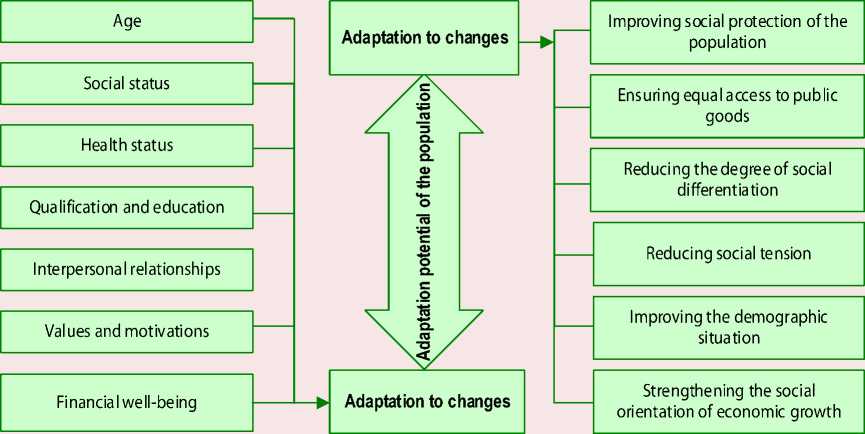
Source: own compilation.
acting as a regulator of social action; diffuseness of the social structure amid growing contradictions between people’s professional qualification and educational level, their place in the system of social reproduction, on the one hand, the size of property and income and social prestige, on the other hand [1; 6]. All these moments trigger acute social stress. Academician of the Russian Academy of Sciences B.T. Velichkovskii points out that this social stress is changing “the fundamental biological regularity – the difference in the stability of the main age groups of the population, since the negative changes in the mortality rate and life expectancy that arise under its influence occur mainly in people of working age rather than in the elderly and children – the most vulnerable age groups” [6].
As for the adaptation strategies of the Russian population, in the conditions of a rapid change of the external environment, according to N.A. Korovnikova, it is rather a process of re-adaptation (or “a change in the changes”) caused by the unpredictability of the future, since traditional adaptation strategies (striving for security, homeostasis, stability) do not catch up with the pace of socio-economic processes and determine the nature and direction of transformations that were associated with profound changes in the system of axiological orientations of the population, including “changes in priorities in relation to their individual needs, the interests of society and the state” [7].
Thus, periods of intense changes always become a testing stage not only for an individual, but also for the whole society, because they force people to mobilize their adaptive capabilities in a changing environment. New survival strategies are emerging and being implemented: from passive forms of retreat, escape from reality to aggressive survival and value simplification [8]. At the same time, social stress is growing, and it weakens the effectiveness of adaptation strategies and increases the impact of negative factors.
When we consider adaptation mechanisms in the “person – environment” system, we see that demographic adaptation represents socially determined forms and ways to implement the needs of an individual or a family that affect population reproduction. It is expressed in changes in reproductive, self-preservation and migration behavior.
Demographic behavior is closely related not so much to socio-economic conditions in which people live, but rather to the perception and subsequent assessment of these conditions. This assessment mainly contributes to the formation of behavioral stereotypes of various socio-economic groups. Thus, all the provisions we have mentioned above are factors that determine the dynamics of demographic indicators. Indicators of fertility, mortality and migration are formed through reproductive, self-preservation and migration behavior and are implemented through the prism of perception of each of the factors according to their degree of significance. Moreover, this perception can be direct and indirect.
A significant amount of studies both in Russia and beyond are devoted to fertility and reproductive behavior of the population. Western demographers, for example P. McDonald and K.W. Wachter, paid great attention to the problems of fertility and its determination [9; 10]. A significant contribution to the development of ideas about fertility and reproductive behavior was made by Russian demographers, economists, sociologists, such as V.N. Arkhangelskii, O.N. Kalachikova, M.A. Gruzdeva, E. Mitrofanova2 and O.V. Semenova [11; 12; 13]. Trends and driving forces of mortality and selfpreservation behavior are considered in the works of E. Karger and D. Westen [14]; M. Seklecka et al. [15], M.A. Miller [16], L.A. Leshchenko [17],
Figure 2. The layout of making a decision on the act of demographic behavior
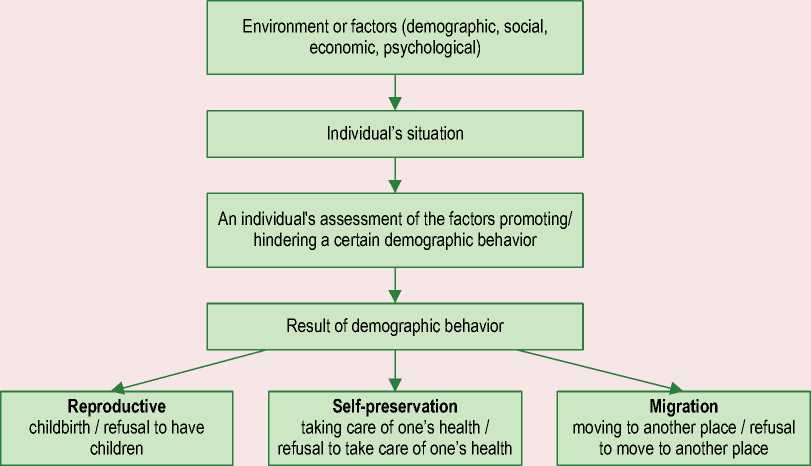
Source: own compilation.
E.A. Trushkova [18], etc. The specifics of migration processes and migration behavior is analysed in the works of S.V. Ryazantsev [19; 20].
In our opinion, the dynamics of demographic indicators is determined by the behavioral mechanism in the implementation of reproductive, selfpreservation, and migration plans and has a pronounced adaptive character (Fig. 2).
In the case of reproductive behavior, the direction of actions related to having/not having a child and the desired number of children is based on the principle of ordering the events perceived by the individual, which are associated with the prospect of striving for the best results for this individual (family). In self-preservation behavior, the individual’s self-preservation attitudes are correlated with his/her current life situation. On the basis of this ratio, an assessment of priorities is made, which results in the adjustment of the lifestyle toward improvement (preservation of health) or rejection, and sometimes aggravation of the negative components of the lifestyle. In this way, a decision is made in the case of migration behavior (to change the place of residence or not). The dynamics of demographic indicators become the observed result of the adaptation of demographic behavior. Assessing this dynamics is the goal of our study.
Data and methods
The methodological basis for our study was the provision that demographic behavior includes three components (reproductive, self-preservation, migration), and specific features of demographic dynamics models are associated with the adaptation of the population to the changing conditions of socio-economic environment for each of these components.
We substantiate and interpret demographic dynamics models by analyzing the dynamic series of the corresponding indicators:
-
– fertility indicators include crude birth rate, total fertility rate, age-specific fertility rates for women of fertile age;
-
– mortality rates are estimated by the crude death rate, infant mortality rate, life expectancy;
-
– the dynamics of migration indicators are represented by the coefficient of migration gain.
The study uses data from the Federal State Statistics Service of Russia for 2000–20193.
Results and discussion
The adaptation of demographic behavior is analyzed on the example of Russia’s demographic dynamics indicators for 2000–2019. Figure 3 shows that the dynamics of indicators of natural and mechanical movement of the population during this period were contradictory – there were periods of improvement as well as deterioration.
We have identified the following periods depending on the state of the socio-economic environment surrounding individuals, and the actions of those factors under the influence of which the adaptation of demographic dynamics takes place:
-
1) the period of 2000–2006, associated with a stable economic situation, an increase in people’s welfare and the purchasing power of income, as well as a favorable psychological climate in society, which was reflected in a decrease in mortality rates, an increase in the birth rate; in addition, since 2003, migration gain dynamics have been positive;
-
2) the period of 2007–2015, associated, on the one hand, with the deterioration of economic development indicators as a result of a series of crises, starting with the global financial crisis of 2008, which was reflected in the stabilization of the rate of migration gain and even its decline by the end of the period; at the same time, the birth and death rates, being quite inert, maintained positive dynamics; moreover, at the end of the period under consideration, there was a slight natural population gain;
Figure 3. Indicators of Russia’s demographic dynamics in 2000–2019
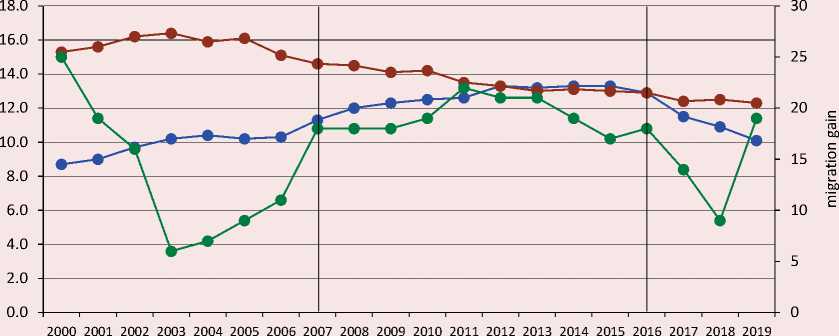
—•— Birth rate per 1,000 people
• Death rate per 1,000 people
—•— Migration gain per 10,000 people
Source: Regions of Russia. Socio-Economic Indicators . Available at: https://rosstat.gov.ru/folder/210/document/13204 (accessed: March 25, 2021).
-
3) the period of 2016–2019, associated with a further complication of the economic situation due to the sanctions policy against the Russian Federation, dramatic decline in real incomes and deterioration of the psychological climate in society; all this had a negative impact on the birth rate and migration gain while mortality stabilized.
A more profound analysis of trends and drivers of demographic dynamics based on a wide set of statistical data4 and conducted with the use of logical and mathematical analysis allowed us to identify the main characteristics of demographic dynamics models in the context of the main components5. According to the Table, for the period from 2000 to 2019, there have been significant changes in the demographic dynamics, which are closely related to the adaptation of the population to new socio-economic challenges and which are an integral element of the modern socio-economic, historical and cultural stage in the development of the Russian Federation.
Patterns of the dynamics of demographic indicators in the conditions of adaptation to the changes in the environment
Stage Fertility indicators Mortality indicators Migration indicators 2000– 2006 Increase in TFR* from 1.19 to 1.29 births; high birth rate in the group of women aged 15–19 (27.4‰); peak birth rate in the group aged 20–24; sharp decrease in the birth rate in older age groups: 35–39, 40–44, 45–49 years of age Mortality rate remained at 15.3–16.4‰; infant mortality rate decreased from 13.3 to 10.2‰; life expectancy increased from 65.3 to 66.6 years; key factors: accessibility of healthcare services and life safety Coefficient of migration gain has significantly decreased: from 25 to 11 people per 10,000 people; key factors: not only high rates of population entry, but also significant indicators of population outflow from the current place of residence 2007– 2015 Significant increase in TFR from 1.29 to 1.7 births; decrease in intensity of births in the group aged 15–19 to 24‰; concentration of births in the groups of 20–24 and 25–29 years of age; sharp increase in the birth rate in older age groups: 35–39, 40–44, 45–49 years of age; key factor is the introduction of maternity capital Mortality rate decreased from 14.6 to 13.0‰; infant mortality rate decreased from 9.4 to 6.5‰; life expectancy increased from 67.5 to 71.4 years; key factors: accessibility of healthcare services, high quality of life and decent working conditions Coefficient of migration gain has stabilized at the level of 17–18 people per 10,000 people; peak value was in 2011 and amounted to 22 people per 10,000 people; key factors: on the one hand, decline in Russia’s economic attractiveness for those who enter into Russia; on the other hand, lack of sufficient income to arrange departure of the population 2016– 2019 Decrease in TFR to 1.58 births; decrease in birth rate in the group aged 15–19 from 24 to 16.1‰; concentration of births falls on three age groups: 20–24, 25–29 and 30–34 years old; high birth rate in older reproductive ages; key factor is the change of reproductive attitudes, postponement of births Mortality rate has stabilized at 12.3– 12.9‰; infant mortality rate decreased from 6.0 to 4.9‰; life expectancy increased from 71.9 to 73.3 years; key factors: decent working conditions and, to a lesser extent, availability of healthcare Coefficient of migration gain has stabilized at the level of 18–19 people per 10,000 people; at the same time, in 2018, it dropped dramatically to 9 people per 10,000 people; key factors: on the one hand, decline in Russia’s economic attractiveness for those who enter into Russia; on the other hand, lack of sufficient income to arrange departure of the population * TFR – total fertility rate. Sources: Regions of Russia. Socio-Economic Indicators. Available at: (accessed: March 25, 2021); [21; 22].
4 Regions of Russia. Socio-Economic Indicators. Available at: (accessed: March 25, 2021).
5 These models showing the dynamics of demographic indicators are based on our research published at the previous stages of the work [21; 22].
Figure 4. Models reflecting the dynamics of demographic indicators in the conditions of adaptation of the population to the changes in the socio-economic environment
Model 1
Model 2
Model 3
B D М
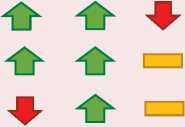
(B – birth rate; D – death rate; M – migration) Source: own compilation.
In particular, the evolution of the birth rate was expressed in a decrease in such indicators as crude birth rate and total fertility rate, which reflects the orientation toward a small family as a response to a high level of instability, since individuals make their choice based on the rational possibility of creating optimal conditions for supporting and upbringing their child.
In addition, an increase in the average age of motherhood and age-related fertility rates in favor of women of older fertile groups is associated with a change in value attitudes and women’s orientation toward education and career. Also, the increase in age-specific birth rates in older ages is due to the desire to acquire financial independence and economic viability, and the development of reproductive medical technologies.
Changes in the dynamics of population mortality rates are associated, first, with the development of medical technologies for providing emergency and high-tech care, focus on the prevention of morbidity, and increase in the detection of diseases. Second, improving the standard of living and promoting a healthy lifestyle, among other things, through the media, stimulate a change in people’s value attitudes and promote health preservation and life-prolonging strategies.
In addition, the structural readjustment of the economy and the development of service industries have led to a reduction in the number of people employed in harmful and dangerous working conditions; it reduces the risks of injuries and occupational diseases and has a positive effect on the mortality rates.
The nature of the dynamics of population migration indicators in 2000–2019 has also undergone changes. The stabilization of the volume of migration flows is associated with the state migration policy implemented over the past years, a decrease in economic incentives for migration, as well as the exhaustion of migration potential.
Thus, we can say there exist three models for the dynamics of demographic indicators that have developed as a result of people’s adaptation to the changes in the socio-economic environment (Fig. 4) .
The first model, which has developed in the conditions of a stable macroeconomic situation and an increase in people’s welfare, includes an improvement in the indicators of the natural movement of the population (birth rate and mortality) with a decrease in the intensity of mechanical movement.
The second model is characterized by a further improvement in the indicators of the natural movement of the population with the stabilization of the volume of migration flows, which is primarily due to the deterioration of the macroeconomic situation.
The third model is determined by the preservation of the positive trend of reducing mortality and stabilizing migration flows, while there is a decrease in the birth rate against the background of a decline in living standards and a lack of people’s confidence in the future.
Thus, the hypothesis about the adaptive nature of the dynamics of demographic indicators in connection with the change in the conditions of the socio-economic environment was confirmed.
Conclusion
The current stage of Russia’s development is characterized by intensive changes in the socioeconomic condition of society; these changes are associated with the instability of the macroeconomic situation and the transformation of the technological and social foundations of social development. The uncertainty of the future path of development, the lack of confidence in the future, and a high level of stress are reflected in demographic indicators – the birth rate is decreasing and the death rate is increasing, despite all the efforts of the authorities to implement an active demographic policy.
Based on the results of the study, we have identified three models reflecting the dynamics of demographic indicators of Russia. They are linked to the specifics of the socio-economic development of the country in different periods and they differ in the nature of reproductive, self-preservation and migration behavior; this is what determines the scientific novelty of our present work.
The practical significance of the research lies in the possibility of using the acquired knowledge in the practice of state and regional management and strategic planning when substantiating effective measures of demographic policy.
Список литературы Models for the dynamics of demographic indicators in the conditions of population adaptation to changes in the socio-economic environment
- Avraamova E.M., Loginov D.M. Adaptive resources of the population: an attempt to quantify. Monitoring obshchestvennogo mneniya: ekonomicheskie i sotsial’nye peremeny=Monitoring of Public Opinion: Economic and Social Change, 2002, no. 3(59), pp. 13–17 (in Russian).
- Pasovets Yu.M. Adaptation of the population to social changes and its indicators. Izvestiya VUZov. Severo-Kavkazkii region. Obshchestvennye nauk=University News. North-Caucasian Region. Social Sciences Series, 2015, no. 1, pp. 28–35 (in Russian).
- Smoleva E.O. Criteria and resources for social adaptation of Russia’s population. Economic and Social Changes: Facts, Trends, Forecast, 2019, vol. 12, no. 2, pp. 179–195. DOI: 10.15838/esc.2019.2.62.11
- Nakamura, T. Solow meets Stone-Geary: technological progress and the demographic transition. Metroeconomica, 2018, no. 69(4), pp. 768–790. doi:10.1111/meca.12212
- Gasanov A.S. Social development and adaptation of generations in the transition period. Voprosy strukturizatsii ekonomiki=Economic Structuring Issues, 2007, no. 4. Available at: https://cyberleninka.ru/article/n/sotsialnoe-razvitie-i-adaptatsiya-pokoleniy-v-perehodnyy-period (accessed: March 10, 2021) (In Russian).
- Velichkovskii B.T. Zhiznesposobnost’ natsii. Rol’ sotsial’nogo stressa i geneticheskikh protsessov v populyatsii v razvitii demograficheskogo krizisa i izmeneniya sostoyaniya zdorov’ya naseleniya Rossi [The Viability of the nation. The role of social stress and genetic processes in the population in the development of the demographic crisis and changes in the health status of the population of Russia]. Moscow: Tigle, 2009. 176 p.
- Korovnikova N.A. Features of the socio-economic adaptation of modern Russians. ESPR=Economic and Social Problems of Russia, 2019, no. 1. Available at: https://cyberleninka.ru/article/n/osobennosti-sotsialno-ekonomicheskoy-adaptatsii-sovremennyh-rossiyan (accessed: March 7, 2021) (In Russian).
- Abirov M.S. Modern Russian society, socio-cultural features in the transformation of the social structure in the context of reforms. Gumanitarnye i sotsial’no-ekonomicheskie nauki=The Humanities and Social-Economic Sciences, 2014, no. 4, pp. 107–110 (in Russian).
- Mcdonald, Peter. Gender equity, social institutions and the future of fertility. Journal of Population Research, 2000, vol. 17(1), pp. 1–16. DOI: 10.1007/BF03029445.
- Wachter K.W., Bulatao R.A. (Eds.). Offspring: Human Fertility Behavior in Biodemographic Perspective. Panel for the Workshop on the Biodemography of Fertility and Family Behavior. Washington, DC, 2003. 400 p
- Arkhangel’skii V.N. Reproductive and marital behavior. Sotsiologicheskie issledovaniya=Sociological Studies, 2013, no. 2, pp. 129–136 (in Russian).
- Kalachikova O.N., Gruzdeva M.A. Changes in reproductive behavior and marriage patterns of the Russian population (based on analysis of FSSS sample studies). Sotsial’noe prostranstvo=Social Area, 2018, no. 2(14), pp. 1–12. DOI: 10.15838/sa.2018.2.14.1 (in Russian).
- Semenova O.V., Butovskaya M.L. Fertility in modern Russian society: the role of economic and cultural factors in the context of growing urbanization. Urbanistika=Urban Studies, 2019, no. 2, pp. 49–63. DOI: 10/7256/2310-8673/2019/2/28966 (in Russian).
- Carger E., Westen D. A new way to talk about the social determinants of health. 2010. Available at: https://www.rwjf.org/en/library/research/2010/01/a-new-way-to-talk-about-the-social-determinants-of-health.html (accessed: April 9, 2019).
- Seklecka M., Lazam N.M., Pantelous A.A., Ohare C. Mortality effects of economic fluctuations in selected eurozone countries. Journal of Forecasting, 2018, no. 38(1), pp. 39–62. DOI:10.1002/for.2550
- Miller M.A. Self-preservation behavior of the population as an element of demographic development. Aktual’nye voprosy ekonomicheskikh nauk=Current Issues of Economic Sciences, 2009, no. 8–1, pp. 167–171 (in Russian).
- Leshchenko L.A. Self-consistent behavior and human capital as a social component of health. Vestnik ekonomiki, prava i sotsiologii=The Review of Economy, the Law and Sociology, 2017, no. 2, pp. 176–180 (in Russian).
- Trushkova E.A. Methodical approach to assessment of economical-and-ecological development and the additional effects associated with risk factors from environmental pollution. Vestnik Nauchno-issledovatel'skogo tsentra korporativnogo prava, upravleniya i venchurnogo investirovaniya Syktyvkarskogo gosudarstvennogo universiteta=Bulletin of the Research Center of Corporate Law, Management and Venture Capital of Syktyvkar State University, 2017, no.3, pp. 44–53 (in Russian).
- Ryazantsev S.V. Modern migration policy of Russia: challenges and approaches to improvement. Sotsiologicheskie issledovaniya=Sociological Studies, 2019, no. 9, pp. 117–126. DOI: 10.31857/S013216250006666-5 (in Russian).
- Ryazantsev S.V., Pis’mennaya E.E. International labor migration to Russia. Mezhdunarodnye protsessy=International trends, 2019, vol. 17, no. 4(59), pp. 65–83, DOI: 10.17994/IT.2019.17.4.59.5 (in Russian).
- Kozlova O.A., Sekitski-Pavlenko O.O. Patterns of birth rate and Russian female population reproductive behavior: current trends. Ekonomicheskie i sotsial'nye peremeny: fakty, tendentsii, prognoz=Economic and Social Changes: Facts, Trends, Forecast, 2020, vol. 13, no. 5, pp. 218–231, DOI: 10.15838/esc.2020.5.71.13 (in Russian).
- Makarova M., Kozlova O., Kozlov A. Methodological tools to assess an impact of habitat factors on population health in Russian regions. In: The 13th International Days of Statistics and Economics in Prague, Czech Republic on September 5–7, 2019. Conference proceeding. Prague: LibušeMacáková, MELANDRIUM, 2019. 1756 p. Pp. 1013–1021. Available at: https://msed.vse.cz/msed_2019/sbornik/toc.html. DOI: 10.18267/pr.2019.los.186.101 (accessed: October 23, 2019).

